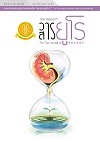The Reduction of Postoperative Pain in Laparoscopic Live Donor Nephrectomy after Bupivacaine Instillation at Renal Bed
Keywords:
bupivacaine, laparoscopic donor nephrectomy, postoperative pain, บิวพิวาเคน, ผ่าตัดบริจาคไตโดยการส่องกล้อง, ความปวดหลังผ่าตัดAbstract
Objective: To evaluate the efficacy of bupivacaine instillation at the renal bed in reduction of postoperative pain and analgesic drugs.
Material and Methods: Twenty patients who underwent laparoscopic live donor nephrectomy from March 2013 to August 2013 at Siriraj Hospital were randomly divided into two groups, the normal saline and bupivacaine groups. At the end of the operation, an agent was introduced at the renal bed. Each patient was given 20 ml of normal saline or 0.5% bupivacaine, according to the group. The numeric rating scale was used to assess the patients’ pain score. The patients were given the analgesic drugs according to their pain scores. Data were compared between the groups and statistically analyzed.
Results: There was no difference in the characteristics between the groups. The patients in the normal saline group required more total morphine at postoperative 12 hours (3 mg VS 1.5 mg) ), but this finding failed to reach statistical significance (p=0.912). In the bupivacaine group, the median pain score at first pain was lower than in the normal saline group (4 VS 5; p=0.796). In addition, the median pain scores of the patients in bupivacaine group at the time of the first required analgesic drug were lower, as well (4 VS 5; p=0.579). Time to first pain and to the first analgesic requirement was longer in the bupivacaine group; however, there was no significant difference (165 VS 70 minutes; p=0.529 and 235.5 VS 117 minutes; p=0.796). There was no major complication in this study.
Conclusion: Bupivacaine instillation at the renal bed in the patients undergoing laparoscopic live donor nephrectomy trends to reduce analgesic usage in the early postoperative period. The pain scores at first pain were lower in the bupivacaine group. In addition, time to first pain and the first analgesic requirement were longer in the bupivacaine group. This was a pilot study, thus the sample size was limited.
ผลของการบรรเทาความเจ็บปวดของผู้ป่วยที่ได้รับยาบิวพิวาเคนในช่องท้องบริเวณตำแหน่งไตเดิมหลังได้รับการผ่าตัดเพื่อบริจาคไตโดยการส่องกล้อง
ชลัยรัชฎ์ สุขอวยชัย, ธวัชชัย ทวีมั่นคงทรัพย์, ธีระพล อมรเวชสุกิจ, เอกรินทร์ โชติกวาณิชย์, กิตติพงษ์ พินธุโสภณ, ภควัฒน์ ระมาตร์, ไชยยงค์ นวลยง
สาขาวิชาศัลยศาสตร์ยูโรวิทยา ภาควิชาศัลยศาสตร์ คณะแพทยศาสตร์ศิริราชพยาบาล มหาวิทยาลัยมหิดล
บทคัดย่อ
วัตถุประสงค์: เพื่อศึกษาประสิทธิภาพของยาบิวพิวาเคนที่หยอดบริเวณไตเดิม ในการบรรเทาอาการปวดและลดปริมาณยาแก้ปวดที่ผู้ป่วยได้รับ ภายหลังการผ่าตัดเพื่อบริจาคไตโดยการส่องกล้อง
ผู้ป่วยและวิธีการศึกษา: ผู้ป่วยที่เข้ารับการผ่าตัดบริจาคไตโดยการส่องกล้องในโรงพยาบาลศิริราช ระหว่างเดือนมีนาคมถึงสิงหาคม 2556 จำนวน 20 คน โดยผู้ป่วยแต่ละคนจะได้รับการหยอดยาปริมาณ 20 มิลลิลิตร บริเวณตำแหน่งไตเดิมภายหลังการผ่าตัด ซึ่งได้รับการสุ่มแบ่งเป็น 2 กลุ่ม คือ กลุ่มที่ได้รับยาบิวพิวาเคน และกลุ่มที่ได้รับน้ำเกลือ ผู้ป่วยจะได้รับการประเมินความปวดโดยมาตรวัดความปวดแบบตัวเลข และได้รับยาแก้ปวดตามแต่ระดับความปวด ผลการศึกษาจะถูกนำมาเปรียบเทียบในแต่ละกลุ่มและคำนวณทางสถิติ
ผลการศึกษา: ภายหลังการผ่าตัด 12 ชั่วโมง กลุ่มผู้ป่วยที่ได้รับการหยอดน้ำเกลือ ต้องการค่าเฉลี่ยปริมาณยาแก้ปวดมอร์ฟีนมากกว่ากลุ่มผู้ป่วยที่ได้รับการหยอดยาบิวพิวาเคน (3 มิลลิกรัมและ 1.5 มิลลิกรัม ตามลำดับ) แต่ไม่มีความแตกต่างกันทางสถิติ (p=0.912) นอกจากนี้ ผู้ป่วยในกลุ่มที่ได้ยาบิวพิวาเคน มีคะแนนปวดในขณะปวดครั้งแรก และเมื่อได้รับยาแก้ปวดครั้งแรกน้อยกว่าในกลุ่มที่ได้รับน้ำเกลือ (คะแนน 4 และ 5 ตามลำดับ) โดยระยะเวลาที่ผู้ป่วยรู้สึกปวดและต้องการยาแก้ปวดภายหลังการผ่าตัดในกลุ่มที่ได้รับการหยอดยาบิวพิวาเคนยาวนานกว่าในกลุ่มที่ได้รับการหยอดน้ำเกลือ อย่างไรก็ตามไม่มีนัยสำคัญทางสถิติ
สรุป: ผู้ป่วยหลังได้รับยาบิวพิวาเคนบริเวณตำแหน่งไตเดิมภายหลังการผ่าตัดเพื่อบริจาคไตโดยการส่องกล้อง มีแนวโน้มที่จะได้รับยาแก้ปวดลดลงในช่วงแรกภายหลังการผ่าตัด นอกจากนี้ ยังมีการลดลงของคะแนนปวดและมีอาการปวดช้ากว่าอย่างไรก็ตามการศึกษานี้เป็นการศึกษานำร่อง จึงต้องมีการศึกษาเพิ่มเติมต่อไป


